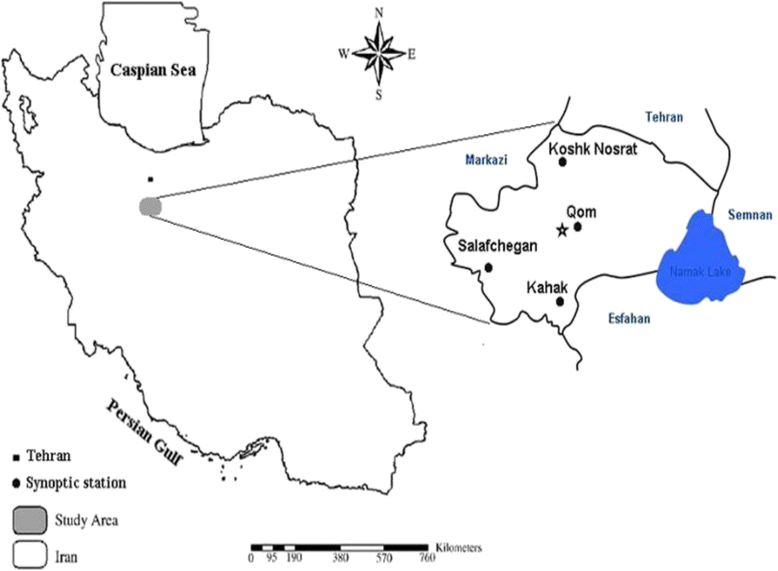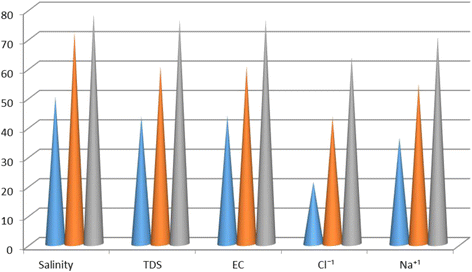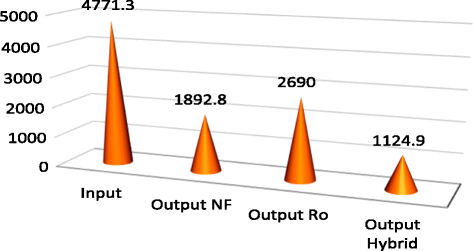An investigation of desalination by nanofiltration, reverse osmosis and integrated (hybrid NF/RO) membranes employed in brackish water treatment
- PMID: 28736617
- PMCID: PMC5521065
- DOI: 10.1186/s40201-017-0279-x
An investigation of desalination by nanofiltration, reverse osmosis and integrated (hybrid NF/RO) membranes employed in brackish water treatment
Abstract
Background: As an appropriate tool, membrane process is used for desalination of brackish water, in the production of drinking water. The present study aims to investigate desalination processes of brackish water of Qom Province in Iran.
Methods: This study was carried out at the central laboratory of Water and Wastewater Company of the studied area. To this aim, membrane processes, including nanofiltration (NF) and reverse osmosis (RO), separately and also their hybrid process were applied. Moreover, water physical and chemical parameters, including salinity, total dissolved solids (TDS), electric conductivity (EC), Na+1 and Cl-1 were also measured. Afterward, the rejection percent of each parameter was investigated and compared using nanofiltration and reverse osmosis separately and also by their hybrid process. The treatment process was performed by Luna domestic desalination device, which its membrane was replaced by two NF90 and TW30 membranes for nanofiltration and reverse osmosis processes, respectively. All collected brackish water samples were fed through membranes NF90-2540, TW30-1821-100(RO) and Hybrid (NF/RO) which were installed on desalination household scale pilot (Luna water 100GPD). Then, to study the effects of pressure on permeable quality of membranes, the simulation software model ROSA was applied.
Results: Results showed that percent of the salinity rejection was recorded as 50.21%; 72.82 and 78.56% in NF, RO and hybrid processes, respectively. During the study, in order to simulate the performance of nanofiltartion, reverse osmosis and hybrid by pressure drive, reverse osmosis system analysis (ROSA) model was applied. The experiments were conducted at performance three methods of desalination to remove physic-chemical parameters as percentage of rejections in the pilot plant are: in the NF system the salinity 50.21, TDS 43.41, EC 43.62, Cl 21.1, Na 36.15, and in the RO membrane the salinity 72.02, TDS 60.26, EC 60.33, Cl 43.08, Na 54.41. Also in case of the rejection in hybrid system of those parameters and ions included salinity 78.65, TDS 76.52, EC 76.42, Cl 63.95, and Na 70.91.
Conclusions: Comparing rejection percent in three above-mentioned methods, it could be concluded that, in reverse osmosis process, ions and non-ion parameters rejection ability were rather better than nanofiltration process, and also better in hybrid compared to reverse osmosis process. The results reported in this paper indicate that the integration of membrane nanofiltration with reverse osmosis (hybrid NF/RO) can be completed by each other probably to remove salinity, TDS, EC, Cl, and Na.
Keywords: Desalination; Groundwater; Hybrid (NF/RO); Nanofiltration membrane; Reverse osmosis membrane; Reverse osmosis system analysis (ROSA) model.
Conflict of interest statement
Ethics approval and consent to participate
Not applicable.
Consent for publication
Not applicable.
Competing interests
The authors declare that they have no competing interests.
Publisher’s Note
Springer Nature remains neutral with regard to jurisdictional claims in published maps and institutional affiliations.
Figures







Similar articles
-
A systematic approach towards optimization of brackish groundwater treatment using nanofiltration (NF) and reverse osmosis (RO) hybrid membrane filtration system.Chemosphere. 2022 Sep;303(Pt 3):135230. doi: 10.1016/j.chemosphere.2022.135230. Epub 2022 Jun 7. Chemosphere. 2022. PMID: 35688189
-
Response surface methodology and artificial neural network modelling for the performance evaluation of pilot-scale hybrid nanofiltration (NF) & reverse osmosis (RO) membrane system for the treatment of brackish ground water.J Environ Manage. 2021 Jan 15;278(Pt 1):111497. doi: 10.1016/j.jenvman.2020.111497. Epub 2020 Oct 29. J Environ Manage. 2021. PMID: 33130432
-
Evaluation of the hybrid system combining electrocoagulation, nanofiltration and reverse osmosis for biologically treated textile effluent: Treatment efficiency and membrane fouling.J Environ Manage. 2021 Sep 15;294:113042. doi: 10.1016/j.jenvman.2021.113042. Epub 2021 Jun 12. J Environ Manage. 2021. PMID: 34126531
-
Reverse osmosis desalination: water sources, technology, and today's challenges.Water Res. 2009 May;43(9):2317-48. doi: 10.1016/j.watres.2009.03.010. Epub 2009 Mar 18. Water Res. 2009. PMID: 19371922 Review.
-
Frontiers of Membrane Desalination Processes for Brackish Water Treatment: A Review.Membranes (Basel). 2021 Mar 29;11(4):246. doi: 10.3390/membranes11040246. Membranes (Basel). 2021. PMID: 33805438 Free PMC article. Review.
Cited by
-
Performance Evaluation of UF Membranes Derived from Recycled RO Membrane, a Step towards Circular Economy in Desalination.Membranes (Basel). 2023 Jun 28;13(7):628. doi: 10.3390/membranes13070628. Membranes (Basel). 2023. PMID: 37504994 Free PMC article.
-
Progress in Research and Application of Nanofiltration (NF) Technology for Brackish Water Treatment.Membranes (Basel). 2021 Aug 28;11(9):662. doi: 10.3390/membranes11090662. Membranes (Basel). 2021. PMID: 34564479 Free PMC article. Review.
-
Insight into Iron(III)-Tannate Biosorbent for Adsorption Desalination and Tertiary Treatment of Water Resources.ACS Omega. 2024 Dec 19;10(1):239-260. doi: 10.1021/acsomega.4c05152. eCollection 2025 Jan 14. ACS Omega. 2024. PMID: 39829501 Free PMC article.
References
-
- Tsiourtis NX. Desalination and the environment. Desalination. 2001;141(3):223–236. doi: 10.1016/S0011-9164(01)85001-3. - DOI
-
- Organization WH . Recommendations: World Health Organization. 2008. Guidelines for drinking-water quality [electronic resource]: incorporating 1st and 2nd addenda.
-
- Mahvi AH, Maleki A, Rezaee R, Safari M. Reduction of humic substances in water by application of ultrasound waves and ultraviolet irradiation. Iran J Environ Health Sci Eng. 2009;6:233–240.
-
- Bazrafshan E, Biglari H, Mahvi AH. Phenol removal by electrocoagulation process from aqueous solutions. Fresenius Environ Bull. 2012;21:364–371.
-
- Mahvi AH, Bazrafshan E, Biglari H. Humic acid removal from aqueous environments by electrocoagulation process using iron electrodes. E-J Chem. 2012;9:2453–2461. doi: 10.1155/2012/581459. - DOI
LinkOut - more resources
Full Text Sources
Other Literature Sources
Research Materials
Miscellaneous

